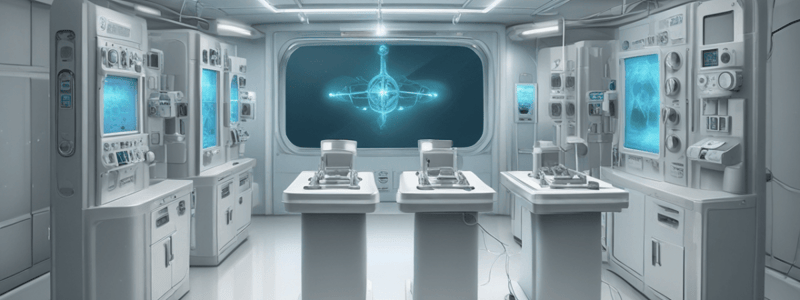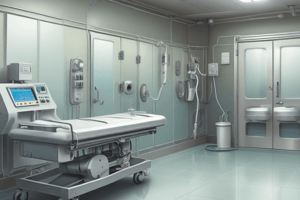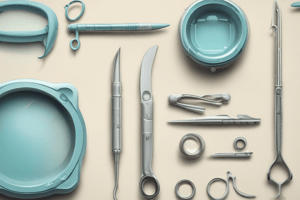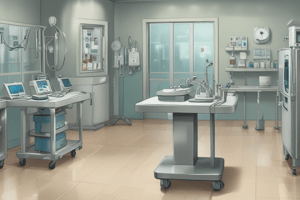Podcast
Questions and Answers
What is the primary purpose of checking the devices for free movement of all parts and non-sticking joints?
What is the primary purpose of checking the devices for free movement of all parts and non-sticking joints?
- To prepare devices for sterilization
- To detect potential wear and tear on devices
- To verify device functionality before use (correct)
- To ensure proper assembly of devices into trays
What is the recommended lubricant to be used on devices if required?
What is the recommended lubricant to be used on devices if required?
- Oil-based lubricant
- Silicone-based lubricant
- Gel-based lubricant
- Water-based lubricant (correct)
What is the importance of checking that the edges of clamping RMD meet with no overlap?
What is the importance of checking that the edges of clamping RMD meet with no overlap?
- To ensure proper meshing of teeth (correct)
- To prevent contamination of devices
- To ensure proper device assembly
- To prevent device damage
Why is it essential to check all screws on jointed RMD for tightness?
Why is it essential to check all screws on jointed RMD for tightness?
What is the primary advantage of using computerized track and trace systems in modern CSSDs?
What is the primary advantage of using computerized track and trace systems in modern CSSDs?
What is the purpose of the handheld barcode readers in the IAP room?
What is the purpose of the handheld barcode readers in the IAP room?
What is generated automatically when a barcode label is scanned by the specialist preparing the tray?
What is generated automatically when a barcode label is scanned by the specialist preparing the tray?
What is the significance of the unique barcode label generated for each tray?
What is the significance of the unique barcode label generated for each tray?
What is the alternative system used by CSSDs that do not have a computerized track and trace system?
What is the alternative system used by CSSDs that do not have a computerized track and trace system?
What is the significance of a new unique unit number being generated each time a new processing cycle begins?
What is the significance of a new unique unit number being generated each time a new processing cycle begins?
Flashcards
What is the IAP area?
What is the IAP area?
Dedicated area in the central sterile supply department (CSSD) where surgical Instruments are inspected, cleaned, assembled, and prepared for sterilization. It's a controlled environment optimized to minimize contamination risk.
What are the environmental requirements for the IAP area?
What are the environmental requirements for the IAP area?
International Organization for Standardization (ISO) 14644-1:1999 Class 8 or equivalent. This ensures a controlled environment with minimal airborne particles.
What happens after instruments are cleaned in the washer-disinfector?
What happens after instruments are cleaned in the washer-disinfector?
Clean instruments are unloaded from the washer-disinfector, visually inspected for cleanliness, damage, and functionality before moving to the sterilization process.
What quality checks are done after the washer-disinfector cycle?
What quality checks are done after the washer-disinfector cycle?
Signup and view all the flashcards
What quality checks are done for manually cleaned devices?
What quality checks are done for manually cleaned devices?
Signup and view all the flashcards
What happens during the inspection stage of the IAP process?
What happens during the inspection stage of the IAP process?
Signup and view all the flashcards
What is function testing in IAP?
What is function testing in IAP?
Signup and view all the flashcards
How are instruments assembled in IAP?
How are instruments assembled in IAP?
Signup and view all the flashcards
What are the key steps in the assembly stage?
What are the key steps in the assembly stage?
Signup and view all the flashcards
What role does the computerized track and trace system play?
What role does the computerized track and trace system play?
Signup and view all the flashcards
Study Notes
Inspection, Assembly, and Packaging (IAP) Area
- The IAP area is a clean area in the CSSD where surgical instruments are inspected for intactness, cleanliness, and functionality.
- Trained decontamination specialists and technicians handle the instruments in this area according to the manufacturer's IFU.
- The area is designated and controlled to optimize sterilization and minimize contamination risk.
Environmental Requirements for IAP
- Ventilation meets clean room standards according to ISO 14644-1:1999 Class 8 or equivalent international standards.
- The room is maintained under positive pressure to ensure air flows outward when doors are opened.
- The environment is kept at 20-23°C with a relative humidity of 30-60%.
- Environmental cleaning follows approved hospital policies and procedures.
- Furniture is made of smooth, non-porous, easy-to-clean materials.
- Shoes must be worn with protective covers to prevent contamination.
Washer-Disinfector (WD) to Sterilizer
- Clean, disinfected surgical instruments and accessories are unloaded from the washer-disinfector.
- Automated or manual unloading processes are used, depending on the equipment.
- Quality checks are performed before further processing, including:
- Correct cycle selection
- Spray arms not blocked
- No soil or staining
- Correct operating cycle
- Visual inspection for damage, staining, or residue
- Visual inspection for dryness
Manually Cleaned Device Acceptance
- Quality checks are also performed for manually cleaned devices, including:
- No visible soil or staining
- Items must be dry before moving to the IAP room
- No damage or incorrect handling
- Correct disassembly
- Documentation completed
Inspection and Function Testing
- Surgical devices are inspected for cleanliness, stains, corrosion, cracks, breakage, and stiffness of movable parts.
- Devices are inspected under magnification where possible.
- Each RMD is inspected separately, including:
- Box joints, serrations, and crevices
- Hinges and movable parts
- Jaws and teeth alignment
- Ratchets and easy closure
- Cannulated devices for patent channels
- Function testing of telescopes and light cables
- Completeness of device sets
- Cutting edges for sharpness
- Insulated devices for intact insulation
- Free movement of all parts and non-sticking joints
- Water-based lubricant use (if required)
Assembly and Checking
- Devices are assembled into their respective trays after inspection and function testing.
- Computerized track and trace systems are used to track devices and device trays through the decontamination process.
- The system includes handheld barcode readers, PCs, and packing lists with unique barcode labels.
- A manual system may be used in the absence of a computerized system.
Studying That Suits You
Use AI to generate personalized quizzes and flashcards to suit your learning preferences.




